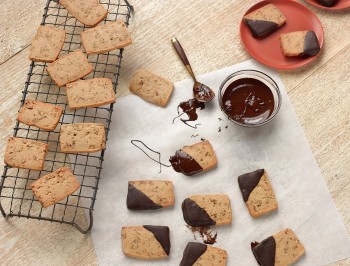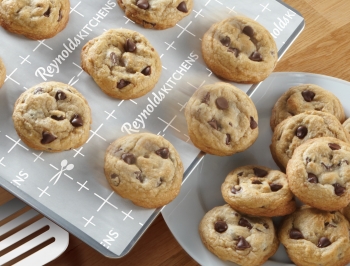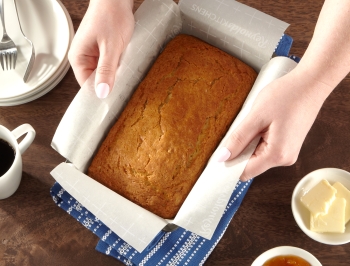Tips for Baking with Parchment Paper
Make perfect cookies every time. The easiest way to get perfect baked goods every time is with Reynolds Kitchens® Parchment Paper. Reynolds Kitchens gives you simple tips so you can bake your best batch.
Last updated: April 24, 2025
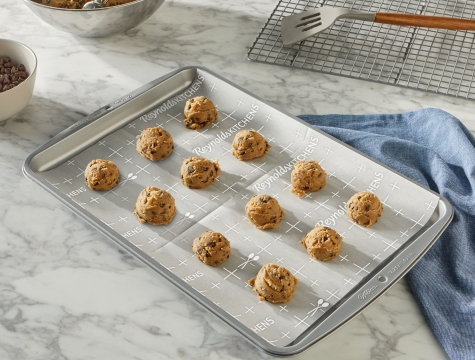
Are you craving perfectly baked cookies or fresh-from-the-oven pizza? Reynolds Kitchens® Parchment Paper is an essential tool for baking treats and savory foods with ease. Discover our best secrets for baking with parchment paper that will level up your baking skills!
If you’re a baking enthusiast, parchment paper is a must-have for baking cakes, brownies, cookies, pies, tarts, breads, and muffins in the oven. But parchment paper goes beyond sweet treats. It can help you make dishes like roasted vegetables, oven-baked bacon, parchment packet cooking, and sheet pan meals with less mess because your foods won’t stick to the baking sheet.
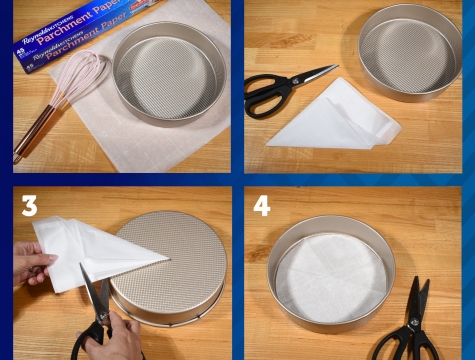
Line a Round Pie Pan with Parchment Paper for Cakes
Who doesn’t love a classic layer cake? They can't be beat for parties, special occasions, or weekend treats! The trick is ensuring your cake layers come out of the baking pans without sticking or breaking. Let us show you how to use parchment paper for cakes to help remove your cake layers from the pans effortlessly.
HOW TO REMOVE CAKES FROM PANS WITHOUT BREAKING
Want to bake flawless cakes that don't cling to the pan? Tear a sheet of Reynolds Kitchens® Parchment Paper that’s one inch larger than your pan. Fold and cut your sheet as directed in our step-by-step instructions on how to make a parchment liner for round cake pans. Then, unfold the parchment circle and place the liner inside the pan.
Next, pour your delicious batter into the pan. Follow your baking instructions. Remove from the oven and cool the cake pan on a wire rack.
WAIT UNTIL THE CAKE IS COOL TO REMOVE PARCHMENT PAPER
Let your cake cool for about 15 to 20 minutes. Flip the cake upside down on a fresh parchment or wax paper sheet. Carefully remove the pan. Then, slowly peel the parchment paper liner from the edges and work inward to the center of the cake to avoid crumbling the edges.
YOU’LL NEED…
Parchment Paper With Stay Flat Dispensing
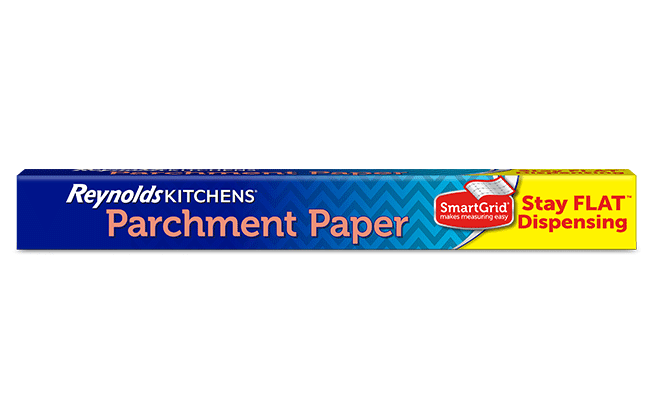
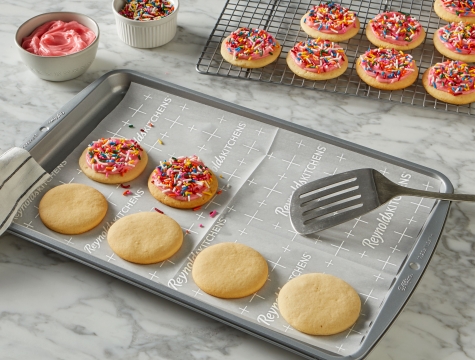
Line Your Pan with Parchment Paper for Baking Cookies
Looking to streamline your baking process? Line your cookie sheets and pans with Reynolds Kitchens® Stay Flat Parchment Paper or Reynolds Kitchens® Cookie Baking Sheets to prevent sticky messes between batches and—best of all—even your most delicate cookies slide right off the pan.
With our handy SmartGrid®, you can space your cookies evenly and easily cut your parchment sheets to fit any pan size.
When using parchment paper for cookies, make sure it doesn’t hang over the edges or touch the oven walls to avoid burning it. If you’re baking big batches of cookies, you can re-use your parchment paper sheets up to three times.
For an extra time-saver, prepare another batch on a second sheet of parchment while the first one is baking, so you’re ready to go when the first batch is done.
YOU'LL NEED...
Cookie Baking Sheets
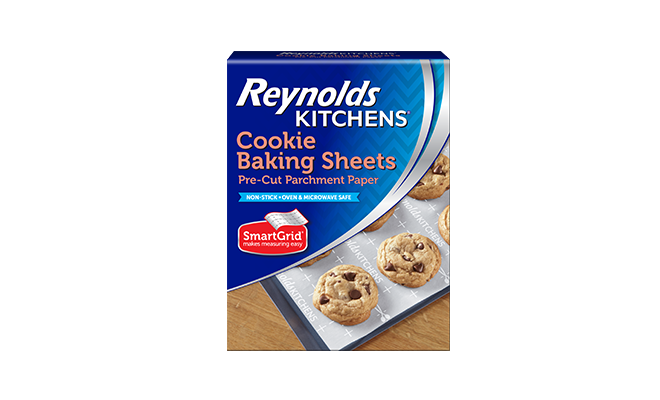
Make a Parchment Paper Piping Bag to Decorate Treats
If you intend to frost and decorate your cookies, use parchment paper underneath your baked and cooled cookies to catch all the excess frosting and sprinkles. Frost and decorate your cookies like a pro with our DIY parchment paper piping bag. Finish off your creations by adding edible decorations if you desire.
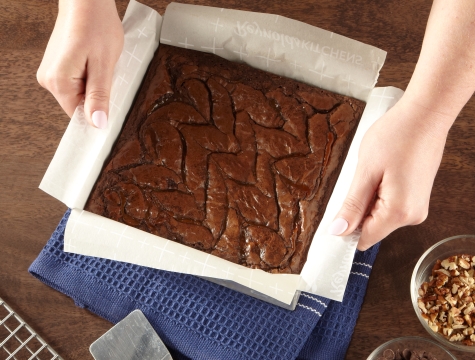
Make a Baking Sling with Parchment Paper for Brownies
You will always want to go with a baking sling once you use this method for baking dessert in a square or rectangular pan, such as cakes, brownies, bars, breads, or fudge. Your baked goods lift right out of the pan for easy slicing!
HOW TO LINE A PAN WITH PARCHMENT PAPER TO MAKE A BAKING SLING
If you're looking for baked goods that can easily be removed from the pan, require minimal clean-up, and are a breeze to slice, you’ll want to try the baking sling. It’s a simple trick using two lengths of parchment paper extending one inch above the pan's rim so the parchment paper doesn’t touch the oven racks or wall. The extra parchment paper becomes the “handles” after your baked goods cool. You can simply lift the baked goods from the pan onto a cutting board and slice your treats evenly. This is a time-saving method for fast, delicious brownies, cakes, and breads that don’t stick!
Don’t have baking pans? Or perhaps you want a disposable, transportable pan for take-along? Use our ready-to-go disposable aluminum foil parchment-lined bakeware.
Make DIY Parchment Paper Liners for Muffins and Cupcakes
The easiest way to line your pan with muffins and cupcakes is with Reynolds Kitchens® Baking Cups. But if you are in a bind, you can make DIY muffin liners from parchment paper.
Parchment paper can be easily fashioned into liners. Cut parchment paper for cupcakes or muffins into five-inch squares. Flip over a small glass or a can and gently press each parchment square over the bottom of the glass or can to shape it into a baking cup. Drop the baking cups into the muffin tin and fill with batter. Genius!
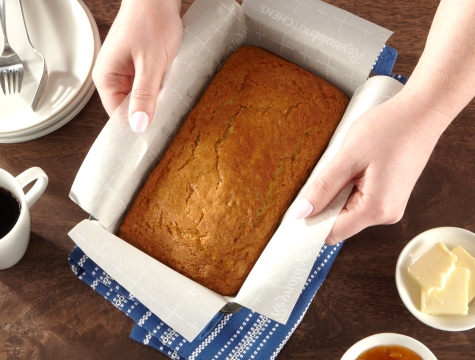
Use Parchment Paper for Baking Bread and Transferring Bread Dough
Using parchment paper is always a good idea when baking bread at home. It makes handling the dough effortless and adds a protective layer that helps the bottom crust from becoming overbaked or sticking to your pan. Plus, your bread will still have the highly desirable crunchy crust.
Parchment paper is excellent for kneading and shaping the dough. Use a large sheet of parchment paper to knead your dough, then place the dough in a proofing basket, cloth-lined bowl, or other container that is two to three times the size of the dough to allow for rising.
Once proofing is done, you’ll want to transfer your bread dough into your baking pan and bake it. Cut a sheet of parchment paper to fit the dough with a few inches of overlap to make parchment baking sling “handles” (see tip three on how to make a baking sling). Place the parchment sheet over the proofed dough and invert the proofing basket or container onto the parchment paper sling. Then, grab the parchment handles and carefully slide the dough into your baking pan. Bake your bread as directed by your recipe. When your bread is cooled, simply lift the bread out of your pan and gently peel off the parchment paper.
HOW TO KEEP PARCHMENT PAPER FROM STICKING TO BREAD
If your bread dough is stickier than it should be and sticks to your parchment paper, try one of these solutions:
- Add a very light dusting of flour or brush a very light coating of oil on the parchment paper.
- Warm, wet dough can be solved by placing your dough in the refrigerator until easier to handle before kneading.
- Before flipping the proofed dough onto the parchment baking sling, lightly sprinkle flour on the parchment paper.
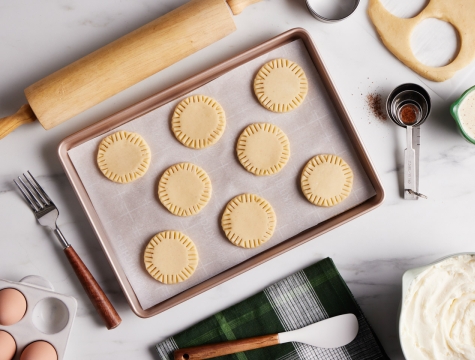
Roll Out Dough Using Parchment Paper for Pastries, Pies, and Cookies
Need help rolling out your dough evenly? Lightly flour two pieces of parchment paper and then roll the dough to your preferred thickness. If you're making cookies, pastries, pie crusts, or pizza dough, feel free to use your favorite cookie, pastry, or pizza cutter. Once done, transfer the dough onto baking sheets lined with new parchment paper and bake as usual.
HOW TO KEEP PARCHMENT PAPER FROM SLIDING WHEN ROLLING DOUGH
Do you want your parchment paper to stay in place while rolling? Here are a few tips:
- Use a small amount of dough to stick on each corner of the parchment paper. Press it down against your rolling surface so it stays put.
- Create a wet seal between the paper and your countertop or rolling surface by misting or slightly wetting it with water or mixing the water with flour or cornstarch.
- Apply a light layer of butter, cooking spray, or oil on the back of the parchment paper and press it down to your surface.
- Tear two sheets long enough to extend over the edge of the counter. Place dough (and lightly flour, if needed) on one sheet. Cover with the second sheet. Prevent the sheets from sliding on the counter as you roll the dough by leaning one hip against the ends of the parchment that extend over the counter's edge to hold them in place.
In addition, you can prevent your dough from sticking to the parchment paper by lightly dusting the paper with cornstarch or flour.
Use Parchment Paper to Keep Savory Foods from Sticking to the Pan
You can use parchment paper for more than just baking sweets. There are easy-to-make and easy-to-clean recipes for weeknight meals, entertaining, and more.
We’re sure these delicious dinner recipes will become fast favorites in your meal rotation:
Need a quick and easy dinner with minimal cleanup? These delicious one-pan sheet pan meals are perfect for busy nights:
- Sheet Pan Spaghetti Squash with Turkey Meatballs
- Sheet Pan Dijon Crusted Chicken Breasts with Baby Potatoes & Green Beans
Craving savory comfort food for binge-watching your favorite show, watching the game, or for a casual gathering? Whip up these warm, comforting dishes and handhelds:
- Spinach and Mushroom Baked Empanadas
- Vegan Nashville Hot “Chicken Sandwich”
- Quick and Easy Baked Ziti
- Vegan BBQ Jackfruit Nachos
- Vegan Mac and Cheese
Parchment packets are an easy way to lock in all the delicious seasonings and flavors that seafood and fish dinners have to offer. Try these savory, tender, and delicious packet cooking meals:
- Ginger Shrimp & Broccoli en Papillote
- Grilled Cod by Reynolds Kitchens Ambassador, Flav City
- Lemon Pepper Cod in Parchment
How to Get Parchment Paper to Lay Flat
Finally! Parchment paper that stays flat. Our new Stay Flat Packaging has a reinforced panel that removes curls so the parchment stays flat. It’s a game-changer—no more fussing over curled-up parchment paper.
YOU'LL NEED...
Parchment Paper With Stay Flat Dispensing

As we’ve explored, parchment paper is a handy tool that helps make baking more manageable with its nonstick quality and easy cleanup. But there’s so much more that parchment can do. Explore our best parchment paper uses that go beyond just baking.
Frequently Asked Questions About Parchment Paper:
Can You Bake With Parchment Paper?
Can Parchment Paper Burn in the Oven?
Can You Bake Cookies on Parchment Paper?
What Can I Use Instead of Parchment Paper for Baking?
While parchment paper is the ideal solution for baking, here are a few substitutes for parchment paper:
- Reynolds Wrap® Non-Stick Foil may be used to line your pans when baking.
- Reynolds Kitchens® Cut-Rite® Wax Paper should not be used as a substitute for parchment paper for cookies or other baking where it is exposed to the oven's heat because it will melt. You may only use wax paper for lining cakes, brownies, or breads where the batter completely covers the wax paper.
Related Tips
